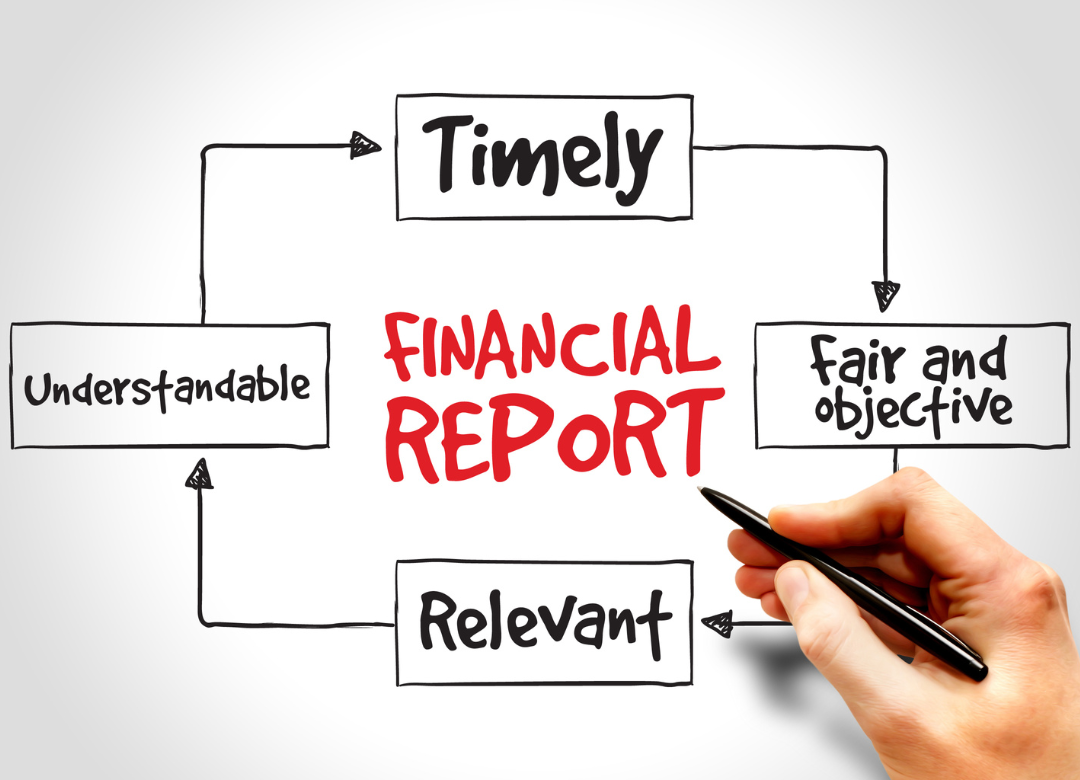Mastering Your Monthly Financial Reports: A Guide for Small Business Owners
As a small business owner, monthly financial report reviews of your company's financial health should be as routine as clocking in each morning. Yet, knowing where to direct your attentive financial gaze isn't always a given. After all, the understanding of numbers, ratios, and financial jargon can be overwhelming, especially when tasked with the day-to-day needs of running a business.
The most successful business owners understand that a clear view of their financial situation is paramount. They make it a priority to review their monthly financial reports with a keen eye, deciphering the story those numbers tell. It's a true demonstration of fiscal responsibility that can make the difference between just staying afloat and actively charting a course toward growth and sustainability.
This blog post will serve as your navigational compass, guiding you through the crucial components of your monthly financial reports and empowering you with the knowledge to make informed decisions that steer your business toward continued success.

The Significance of Monthly Financial Reports
Before delving into the specifics, let's underscore the importance of monthly financial reporting. These documents are not just history lessons. They provide invaluable insights into your business's most profitable pathways, current financial position, and potential pitfalls that may be lurking in the accounts payable or receivable. Think of them as your real-time financial pulse-check – they highlight trends, successes, and areas that require immediate or future attention. As the adage goes, "What gets measured, gets managed."
Interpreting the Story Behind the Numbers
It's often said that numbers don't lie, which is precisely why your monthly financial reports are critical to understanding your business's performance. Each line item holds a narrative—an accumulation of decisions, strategies, and market reactions that collectively form the tale of your business's endeavours.
These numbers should inform not just how you view the past month, but how you strategize for future ones, making insightful adjustments that align with the performance story they are telling. By analyzing trends in revenue, expenses, cash flow, and other financial metrics, you can discern patterns that guide you towards more profitable business moves and away from those that don't bear fruit.
The core purpose of consistently reviewing monthly financial reports is to gain a clear vision of what aspects of your business are thriving and which require intervention. Think of these reports as your business's navigation system, providing you with the data needed to course correct and adjust your trajectory towards success. By recognizing financial strengths, you can capitalize on strategies that yield positive results.

Conversely, identifying weaker areas demands prompt action to mitigate risks or optimize performance, ensuring your business remains on the path to fiscal health and growth.
Moreover, reviewing your monthly financial reports holds you accountable to meeting the goals you've set for your business. It's a regular exercise in responsibility that highlights the progress—or lack thereof—towards your defined milestones. Accountability is paramount, as it compels action and fosters a proactive approach to management.
When you consistently measure your business against its targets, you can quickly pinpoint which strategies are effective and replicate those successes. This process is not just about tracking but about applying the insights gained to improve decision-making and strategic planning, ensuring that each month brings you closer to your long-term business aspirations.
Understanding the Financial Narrative
Your financial reports are the storybooks of your business's journey. Each month a new chapter unfolds, and the combination of reports tells a continuous tale of your financial progress, challenges, and opportunities.

Here's how to interpret the story within the figures:
The Balance Sheet: A Snapshot of Financial Health
The balance sheet is like a Polaroid, capturing a moment in your business's financial life. It's separated into two halves – assets on the left, liabilities and owner's equity on the right. The equation Assets = Liabilities + Equity is more than an accounting fundamental; it's a succinct summary of your business's economic schema. Key elements to scrutinize include:
- Current Ratio: This measures your company's liquidity, comparing current assets to current liabilities. A ratio of 2:1 is generally considered healthy.
- Debt-to-Equity Ratio: Evaluating the proportion of debt to shareholders' equity, this tells you how much leverage your business has. Keeping this ratio in check prevents over-indebtedness and maintains investor confidence.
- Working Capital: The difference between current assets and current liabilities. A positive figure indicates that the business can cover its short-term liabilities comfortably.
The Profit and Loss Statement: Unveiling Profitability
The P&L, also known as the Income Statement, depicts your company's performance over a specific time period. It's a narrative of your business's revenues and expenses, documenting the ebbs and flows of financial activity within:
- Gross Margin: This simple yet powerful metric tells you how effective your company is at generating profit from direct costs. It's a benchmark for pricing strategy and cost control.
- Operating Income and Net Profit: These figures show what's left after all costs, including operating expenses and taxes. They indicate long-term viability and growth potential.
- Trends: Look for consistent trends in income and expenses. Are there seasonal fluctuations, or are certain costs rising unexpectedly? These insights can inform strategic planning and initiative prioritization.

Cash Flow Statement: The Silent Business Partner
Cash flow is often the unsung hero of business longevity. Without a robust understanding of where your cash is coming from and going to, even a business that's turning a profit can run aground. The main categories within the cash flow statement are:
- Operating Activities: Considers cash flow from regular business operations, such as selling goods or providing services. A positive number here is a good indicator of solvency.
- Investing Activities: Tracks cash flow from investments, like buying or selling assets. These decisions can be indicators of growth and stability but may not factor into day-to-day liquidity assessments.
- Financing Activities: Captures cash flow from debt or equity transactions. This is a peek into how you're funding your business and whether you're relying too heavily on one source.
Raising the Red Flags
Just as important as recognizing when business is booming is the ability to discern when the waters are getting choppy. Monthly financial reports can be rife with red flags, gesturing toward operational inefficiencies, cash traps, or worse, fraudulent activity. Here are some red flags to remain vigilant for:
- Inconsistent Transactional Patterns: If there's no rhyme or reason to your financial inflows or outflows, it could indicate mismanagement or even embezzlement.
- High Debt Service: Are you spending a considerable portion of your revenue on servicing debts? This isn't sustainable and may prompt a reevaluation of your financial strategy.
- Declining Profit Margins: Amidst rising costs or severe competition, declining margins can be the canary in the coal mine, warning of potential profitability issues.
- Frequent Overdrafts and Late Payments: Chronic cash shortages can trigger expensive overdraft fees and tarnish creditor relationships. These can quickly spiral into serious business threats.

By being mindful of these financial red flags, business owners can recognize early warning signs of fiscal distress. This awareness facilitates preemptive actions to adjust strategies, reinforcing the adage that forewarned is forearmed. Thus, vigilance in financial oversight serves as a beacon, guiding enterprises away from the shoals of insolvency towards the calmer waters of economic stability.
Understanding these signals is crucial in navigating the complex currents of business finance, empowering you to steer your venture clear of potential pitfalls and maintain a course toward sustainable growth and profitability.
Leveraging Financial Intelligence for Growth
Once you've dissected and understood your financial reports, it's time to apply your newfound financial intelligence to drive strategic decisions that foster growth. This may involve negotiating better payment terms with suppliers, adjusting pricing strategies, or identifying and eliminating areas of waste. Your financial reports are not just scorecards; they're action plans waiting to be written.
By diligently reviewing your monthly financial reports, you set yourself up with a proactive defence against minor issues snowballing into major crises. These documents serve as navigational tools, offering insights and illuminating trends that could go unnoticed without proper scrutiny.
Just as a pilot reacts to the earliest signs of turbulence, a savvy business owner will use financial reports to course correct, ensuring the business trajectory remains aligned with their strategic vision. Such timely adjustments are essential in keeping a business agile and resilient in the face of market volatility.

Integrating Technology into Your Financial Reporting
Technology is your ally in the quest for financial clarity. Accounting software can automate the creation of your monthly reports, reducing human error and freeing up time for analysis and planning. Moreover, cloud-based solutions provide real-time visibility, enabling you to make nimble, data-driven decisions.
The Journey Continues
Monthly financial reporting is not a one-and-done task; it's a continuous journey of learning and adapting. As you become more adept at reading the financial runes, your business acumen will sharpen, leading to more agile and prosperous business operations. Remember, financial health is a marathon, not a sprint. Each month is a step toward the finish line, and with each report, you inch closer to your business's full potential.
The bottom line is that when armed with these insights, your monthly financial reports won't just be another administrative chore. They'll become an integral part of your business's strategic armour—guiding you through the labyrinth of entrepreneurship with clarity, foresight, and the confidence to make the right moves.
Need help navigating your business finances? Don't go it alone. Grab the 5-Step Roadmap to a Profitable Biz to kickstart your journey towards financial mastery. Get started today and take the first step towards transforming your financial reports into engines of growth for your business.


